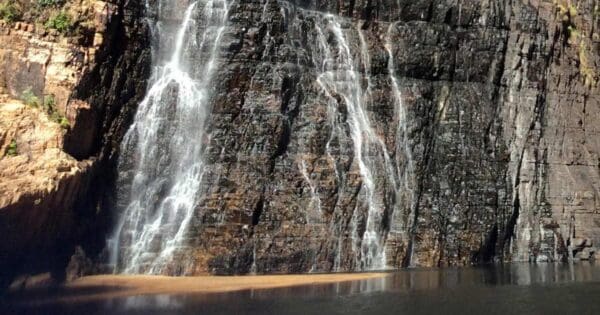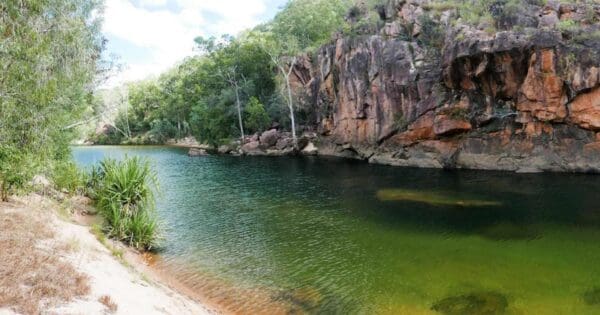Hike at a Glance
Max elevation: 143m
Min elevation: 47m
Total Ascent: 96m
Hike overview
The Mirray Lookout Walk offers a rewarding challenge for those seeking panoramic views within Kakadu National Park. Located halfway between Jabiru and Cooinda along the Kakadu Highway, this 2-kilometre return trail leads to a viewing platform atop Mount Cahill.
While the walk itself is relatively short, be aware of the moderately difficult climb. Sturdy footwear and plenty of water are essential. Plan on allocating approximately 1.5 hours to complete the return journey, factoring in time to appreciate the breathtaking 360-degree view of Kakadu's vast landscapes, including escarpments and floodplains.
The ideal time to tackle this walk is during the dry season (late April to early November) when temperatures are more comfortable.
Remember, a park pass is required to enter Kakadu National Park. Consider purchasing yours online beforehand to save time upon arrival.
The wider Nourlangie region surrounding Mirray Lookout boasts numerous walking tracks, camping options, and other cultural and natural wonders for visitors to explore.
Track grade
Grade 4 (Hard) - Challenging Walks for Experienced Walkers: Grade 4 on the AWTGS signifies challenging walking tracks. Bushwalking experience is recommended for these tracks, which may be long, rough, and very steep. Directional signage may be limited, requiring a good sense of navigation. These walks are suited for experienced walkers who are comfortable with steeper inclines, rougher terrain, and potentially longer distances.
Walk map and GPX file
Max elevation: 143 m
Min elevation: 47 m
Total climbing: 96 m
Total descent: -96 m
Content use
Please don’t copy GPX files or content from this site to AllTrails or other platforms. Each trail has been personally mapped, documented, and refined to support Australia’s bushwalking and hiking community. While some details come from land managers, every listing reflects significant personal effort. This is a free, community-driven initiative—your respect helps keep it that way.
Gallery
Got any photos from this hike? Your photos can help others plan. Share shots from along the trail so fellow hikers know what to expect.
Click to add your photos >>
Getting there
Getting to the trailhead: Kakadu National Park.
Reaching the trailhead for the Mirray Lookout Walk is convenient. Situated within Kakadu National Park, the walk is accessible via Kakadu Highway. As you travel between Jabiru and Cooinda, the two main service centres in the park, keep an eye out for the well-signed turn-off for the walk. Once you depart the highway, follow this road for a short distance until you arrive at the designated carpark for the Mirray Lookout Walk. Here, you can prepare yourself for the rewarding climb to the top.
Need a rental car to get you to the hike? Find one here.
Find a place to stay
Wondering where to stay near this hike? Find accommodation close to the trailhead — hotels, cabins and campgrounds nearby. Click the button to view the interactive map.
Closest towns to this walk: Adelaide River, Arnhem Land, Batchelor, Cooinda, Darwin, Gunbalanya, Humpty Doo, Jabiru, Kakadu Village, Katherine, Maningrida, Mary River, Nourlangie, Pine Creek
Let someone know
Heading out? Fill in a trip intentions form so someone knows your plans. If things go wrong, they can raise the alarm fast, giving you peace of mind on the trail.
About the region
Covering nearly 20,000 square kilometres, Kakadu National Park is a World Heritage listing renowned for both its cultural and natural values. See breathtaking horizons from the top of a Kakadu escarpment. Cruise on the stunning Yellow Water Billabong to spot crocodiles and wildlife in their natural habitat, including millions of migratory birds who in part call the park's wetlands home.
Not only is Kakadu spectacular, but you can feel yourself come alive among the lush rainforests, rocky gorges, serene swimming pools and the oldest Aboriginal rock art in the world. With more than 5,000 Aboriginal rock art sites in the park, the Bininj/Mungguy people have called Kakadu home for some 65,000 years. Here they'll teach you about their ancient culture and the regions' dramatic seasons.
Connect with the oldest living culture on earth. The rugged and remote beauty of Kakadu has stories to share that will take your breath away and touch your heart. In Australia's biggest national park you'll find ancient landscapes with thundering waterfalls, lush rainforests, wandering wetlands, exotic wildlife and ancient rock art.
Kakadu offers unrivalled walks to immerse you in nature, satisfy your appetite for adventure, or nurture your curiosity. Only three hours' drive from Darwin, Kakadu National Park has been waiting for you.
Similar walks nearby
Looking for more walks in or near Kakadu National Park? Try these trails with a similar difficulty grade.
Explore safe
Plan ahead and hike safely! Carry enough water, pack layers for changing conditions, and bring safety gear like a torch, PLB, and reliable communication device. Check official sources for trail updates, closures, and access requirements, and review local weather and bushfire advice. Most importantly, share your plans with someone before you go. Being prepared makes for a safer and more enjoyable hike! Stay Safe, Explore More, and Always #ExploreSafe.
Packing checklists
What you carry in your pack depends on factors like weather, terrain, and your adventure type. Not sure what to bring? My free planning, food, and packing checklists are a great starting point, covering day hikes, overnight trips, and multi-day adventures. Use them to customise your kit and always prioritise safety.
Suggest an edit
Notice something different about this trail? Whether it’s a new feature, a route change, or a closure, share your update so we can keep our info accurate and helpful for fellow hikers.
Click to suggest edits >>
Acknowledgement of Country
Trail Hiking Australia acknowledges the Traditional Owners of the lands on which we hike and pay respects to their Elders, past and present, and we acknowledge the First Nations people of other communities who may be here today.






